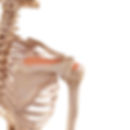Let's Talk About Shoulders
- Oct 1
- 4 min read
The shoulder can be a complicated joint. But before we do a deep dive into all things shoulder, let’s talk about how it got so complicated. We have to look back millions of years to the evolution of human bipedalism.

As we went from quadrupeds to bipeds, the ball and socket joints connecting our limbs to our trunks had to adapt. Standing upright meant our hips had to bear significantly more weight, developing a deeper, more stable socket, with larger bones, and less mobility. Our shoulders, meanwhile, needed a much larger range of motion and more dexterity to be able to swing from trees, and carry things like food and our young. This resulted in a much shallower socket joint in our shoulders. Our tree dwelling ancestors needed this larger range of motion, and the strength of our rotator cuffs, to more efficiently climb up and down the trees they lived in. As early humans spent more time on the ground, developing tools and hunting prey, our shoulders adapted further. Our scapulae shifted from a more upward facing position to a side-facing one, allowing for greater accuracy when throwing and hunting.


This was an evolutionary compromise. We sacrificed the stability of a deeper socket for a greater freedom of movement, allowing us to continue our evolutionary development, but making us more vulnerable to shoulder injuries. I often say to my clients that our shoulders are held together by a system of tendons, ligaments, and hope.
So, with that brief history lesson done, let’s take a look at some of the more common shoulder injuries we bipedal humans face.
Rotator Cuff Injuries:
Probably the most common cause of shoulder pain is a rotator cuff injury. Our rotator cuff is a group of four muscles: supraspinatus, infraspinatus, teres minor, and subscapularis, working together to stabilize the head of the humerus, holding it in place. Any one of these muscles can develop tendonitis from repetitive use or poor posture, or become torn from a dislocated shoulder.




Check out these shoulder stretches isolating each of the rotator cuff muscles:
Frozen Shoulder:
Formally known as adhesive capsulitis, this condition causes shoulder pain, stiffness, and severely limits range of motion when the synovial capsule that wraps around the shoulder joint becomes inflamed and thickens. Typically a doctor will assess a patient with a physical exam to diagnose frozen shoulder, but may use an MRI to rule to our other injuries like a rotator cuff tear or arthritis.

The cause of frozen shoulder can be mysterious: it could be the result of trauma or high levels of stress, or it can happen after recovering from a shoulder injury or surgery if the joint was immobilized for a long period of time. There’s even evidence it can be connected to inflammation stemming from an autoimmune response.
Deep tissue massage therapy to relieve the shoulder tension and pain associated with frozen shoulder is an important way to maintain range of motion and manage pain during recovery, which can take up to two years. Releasing trigger points, in the rotator cuff muscles, and surrounding muscles like teres major, the lats, the pecs, the deltoids, even the biceps and triceps can all help manage frozen shoulder.

Biceps Tendon Subluxation:
Have you ever felt (or heard) a deep clicking, snapping, or clunking sensation in the front of your shoulder joint? It might be a biceps tendon subluxation. Our biceps long-head tendon attaches just above the socket of our shoulder joint and travels down the bicipital groove of the humerus, a subluxation is when that tendon just won’t stay put in its groove.

Repetitive use, especially for throwing athletes and weightlifters, or an injury to a stabilizing ligament can lead to this condition. It can be a tricky issue because sometimes that deep ache doesn’t seem serious enough to seek treatment, but if that biceps tendon is left untreated it can lead to weakness and instability around the shoulder.
These conditions are some of the more common soft tissue shoulder issues that can benefit from regular therapeutic massage. More importantly, a regular routine of bodywork and exercises focused on shoulder stability and mobility can help prevent these issues from happening in the first place. We have a vast library on our YouTube channel of shoulder focused stretches, exercises, and self-care tips. Take a look at some of the highlights below, and check in with your massage therapist during your next session so they can help you build a routine tailored for your shoulder and how you use it so we can keep you throwing, swinging, climbing, and swimming without interruption.
Additional stretches and exercises for the shoulder:
